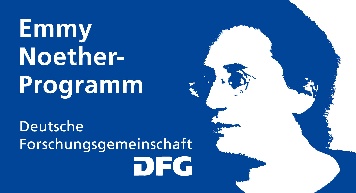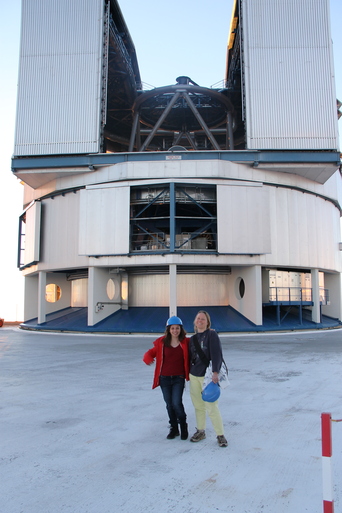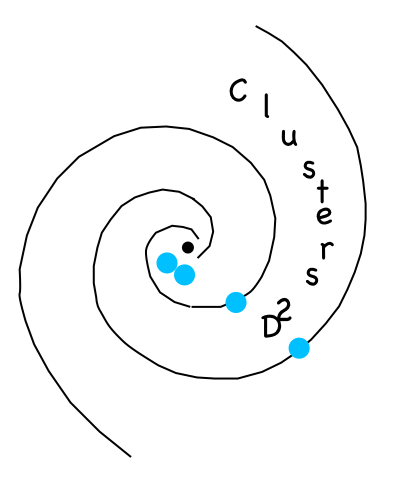Emmy Noether Group: The formation and evolution of starburst clusters


Argelander Institut für Astronomie, University of Bonn
During the past five years, I led an Emmy Noether research group funded by the German Science Foundation. The scientific goal of the research project was to characterise the young, stellar population in starburst clusters in the Milky Way. As a special tool, we used proper motions to obtain membership information and sieve out the cluster members from the dense population of foreground stars, especially in the Galactic center. Two PhD theses were conducted at the University of Bonn during the project, and the fruitful collaboration with the Max-Planck-Institute in Heidelberg led to three further PhDs benefiting from the techniques and the rich data set developed to achieve the science goals.
The most puzzling questions in star cluster formation
Despite several decades of young star-cluster research, some of the most basic characteristics of young, massive star clusters were still unknown. Within the research project, we were able to answer some of these imminent questions. The major results from the projects can be accessed from the linked questions:
Group members
Dr. Andrea Stolte (PI)Dr. Maryam Habibi
| Thesis title: | Starburst clusters in the Galactic center |
| Thesis focus: | Dynamical evolution of Galactic center starburst clusters: |
| Dynamical evolution and time variation of the stellar mass function, tidal destruction and cluster survival. |
Dr. Benjamin Hußmann
| Thesis title: | The Quintuplet Cluster: |
| A young massive cluster study based on proper motion membership | |
| Thesis focus: | Proper motion membership in Galactic center starburst clusters: |
| Constructing an unbiased initial stellar mass function, the disc fraction in the Quintuplet cluster based on proper motion members. |
Science Aims
One of the most heavily debated, and extensively used,
universal quantities in astrophysics is the initial stellar mass function (IMF).
The IMF describes the relative numbers of high- vs. low-mass stars in any given star-forming
region. Any stellar population observed today is a direct result of the IMF during its formation
and the subsequent evolutionary history of the stellar population. In the solar neighbourhood,
the IMF is surprisingly universal. Such universality is unexpected given that gaseous and
stellar densities, pre-stellar core temperatures, and magnetic fields in molecular clouds vary
significantly. One reason for this apparent similarity in the local stellar mass spectrum may
originate from the similar conditions of star-forming clouds in the solar environment.
However, this environment is not characteristic for the extreme starburst regions in external
galaxies, in galactic nuclei, and in dense stellar clusters. The closest environments where
stars form under enhanced temperatures, gas densities, and possibly magnetic pressures are
provided in Milky Way starburst clusters. At the present epoch, these young, massive star
clusters harbour 10,000 solar masses in stars or more, and are formed in rare numbers in the
Milky Way's spiral arms and near the center of the Galaxy.
The Emmy Noether group at the Argelander Institute for Astronomy in Bonn studied resolved
starburst clusters in the Milky Way to answer the universal question as to whether their
initial stellar mass functions are similar to or deviate from the IMF in the solar neighbourhood.
For the Arches and Quintuplet clusters in the Galactic center, we found that the present-day
mass functions are slightly flatter than the standard Salpeter (1955) initial mass distribution.
This implies that more high-mass stars are located in the central regions of these starbursts
than expected from a normal mass spectrum.
As massive star clusters evolve rapidly with time,
the situation is not as simple as it might seem. A detailed analysis of the dynamical evolution
of the Arches cluster suggests that the IMF was normal when the cluster was born. Mass segregation -
the sinking of high-mass stars to the cluster center and the removal of low-mass stars to
the cluster outskirts - caused the present-day MF to appear flat in the cluster core and
steep at large radii. Such a detailed dynamical model is not yet available for the Quintuplet
cluster, hence there the answer remains open whether the cluster started with a flat or normal MF.
These results have implications for our understanding of the multitude of massive, unresolved
extragalactic starburst clusters, where the massive stars contribute the majority of the light,
while the total mass may be dominated by the low-mass stellar content in each cluster.
Clusters2D - The Milky way starburst cluster survey

Since the Emmy Noether group finished, and all PhDs finished their theses with excellent success, the cluster survey has moved to MPIA. It is a pleasure to note that Dr. Wolfgang Brandner has taken over the extensive duty of continuing the proposal and survey effort, after we shared the workload of the survey for more than a decade.
Survey collaboration
Emmy Noether Group, Argelander Inistut für Astronomie, Bonn
-
Dr. Andrea Stolte
Dr. Maryam Habibi (MPE, Garching)
Dr. Benjamin Hußmann
-
Dr. Wolfgang Brandner
Dr. Mario Gennaro (STScI, Baltmore)
Dr. Natalia Kudryavtseva (ARI, Heidelberg)
Dr. Boyke Rochau
Science goals of the survey
With the aim to understand the environmental effects on star cluster formation, a sample of massive star clusters has to be observed and analysed uniformly. The Milky Way provides a small sample of six young, massive clusters securely classified as starbursts with cluster masses in excess of 10,000 solar masses. In this sample, the Arches and Quintuplet clusters located near the center of the Milky Way span ages of 2.5 to 4.5 Myr, and the two spiral arm clusters NGC 3603 and Westerlund 1 cover ages of 2 to 4 Myr. Due to their similar age ranges, these four clusters are ideally suited to probe the differences in cluster evolution between spiral arms and the Galactic center star-forming environment.
- Starburst cluster characteristics
- Spatial extent, stellar mass distribution, density profile
- Dynamical evolution of starburst clusters
- Survival timescales and tidal disruption
- Effects of the environment on cluster evolution
- Formation of spiral arm clusters vs. Galactic center clusters
- Tidal effects
- Initial stellar mass function
Methods
- Proper motion membership
- 4 clusters with at least 2 epochs
- Precision astrometry from diffraction-limited imaging
- VLT/NAOS-CONICA
- natural guide star adaptive optics
- near-infrared 1.2 - 2.2 micron (H & K-band)
- 27" field
- HST/WFPC2
- space-based diffraction-limited imaging
- optical 550 - 800 nm (VRI photometry)
- 160" field